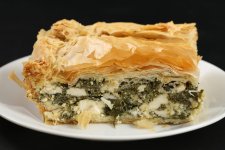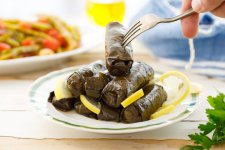Menu
Install the app
How to install the app on iOS
Follow along with the video below to see how to install our site as a web app on your home screen.
Note: This feature may not be available in some browsers.
You are using an out of date browser. It may not display this or other websites correctly.
You should upgrade or use an alternative browser.
You should upgrade or use an alternative browser.
Greek Food, Cooking and Recipe Community
What are some party must haves for mezze?
- Thread starter dpappas87
- Start date
1 - 8 of 8 Posts
dpappas87
Active member
Thanks, I wouldn't even think to include dolmades as an appetizer either! Do you make them yourself? Or do you buy them canned?Where to begin LOL!
Here are some that I would include if having a party and want some Greek mezze: Dolmades (Stuffed Grape Leaves), Tiropira, Spanakopita (really any pita). Although many would include dolmades as a main dish, I think it could work as an appetizer or mezze.
View attachment 80
dubai_suzie
Active member
I’m sure you know of the classics like babaghanoush, tzatziki, olive spread, pita bread and that type of stuff. I love adding hummus and spinach/artichoke dip. It’s not traditionally Greek, but I love it! 
k_tsoukalas
Administrator
My favorite is to serve spanakopita because it is always a show stopper. I also like to make a hummus dip where I take hummus and top it with feta cheese, chopped tomatoes, Greek olives, a sprinkling of oregano. It's an easy way to elevate store bought hummus, and it tastes great when served with pita chips.


Those are great ones!!!! Thanks!Taramosalata and beet tzatziki are lesser known but delivious mezze! I love the vibrant color of the beet tzatziki its so pink! Add some walnuts and it delish
kosta_karapinotis
Active member
I’m more of a meat guy so when I make mezze I like to add smaller peices of meat like cut up loukaniko (sausage) or skewers of grilled chicken. It’s nice to eat with pita bread and any of the dips, anything can really become mezze when its plated on little dishes. Good luck!
1 - 8 of 8 Posts
JOIN THE DISCUSSION AND READ OTHER GREEK INFO:
No Meat Dolmades (Stuffed Grape Leaves) Recipe
- ssherie_
- Greek Food Forum
- Replies: 0
It has taken me a long time to get vegetarian dolmades to the point where I enjoy them. Here is my recipe. It uses a lot of oil, so strict fasters shouldn't eat them. But most people aren't super strict so I would even say these are good for lent!
Ingredients:
- 1 jar of grape leaves (about 60-70 leaves)
- 1 cup short-grain rice
- 1 large onion, finely chopped
- 2 cloves garlic, minced
- 1/2 cup chopped fresh dill
- 1/2 cup chopped fresh mint
- 1/2 cup chopped fresh parsley
- 1/4 cup olive oil, plus extra for drizzling
- Juice of 2 lemons
- Salt and pepper to taste
- Water
Instructions:
- Prepare the Grape Leaves:
- If using grape leaves preserved in brine, rinse them well under cold water to remove excess salt. If using fresh grape leaves, blanch them in boiling water for about 1 minute, then drain and rinse with cold water. Trim off any stems.
- Prepare the Filling:
- In a large bowl, combine the rice, chopped onion, minced garlic, chopped dill, chopped mint, chopped parsley, olive oil, lemon juice, salt, and pepper. Mix well to combine.
- Fill and Roll the Grape Leaves:
- Place a grape leaf flat on a clean work surface, shiny side down, with the stem end facing you. Spoon about 1 tablespoon of the rice filling onto the center of the leaf, near the stem end.
- Fold the bottom of the leaf over the filling, then fold in the sides, and roll tightly into a small cylinder.
- Repeat with the remaining grape leaves and filling, arranging the rolled dolmades seam-side down in a large pot or deep skillet, packing them snugly together.
- Cook the Dolmades:
- Once all the dolmades are rolled and packed in the pot, drizzle with a little olive oil and lemon juice.
- Pour enough water into the pot to just cover the dolmades.
- Place a heatproof plate or lid directly on top of the dolmades to keep them submerged during cooking.
- Bring the water to a boil over medium-high heat, then reduce the heat to low, cover the pot, and simmer gently for about 45-60 minutes, or until the rice is cooked and the grape leaves are tender.
Enjoying Cooking with Greek Honey
- axariotisxy
- Greek Food Forum
- Replies: 1
One of the things I love most about Greek honey is its versatility. You can use it in so many different ways in the kitchen. I've drizzled it over Greek yogurt for breakfast, mixed it into salad dressings for a touch of sweetness, and even used it as a glaze for roasted vegetables. The depth of flavor it adds to dishes is truly remarkable.
But perhaps my favorite way to use Greek honey is in baking. It adds a wonderful depth of flavor to cakes, cookies, and pastries. I recently made a batch of baklava using Greek honey, and it was a game-changer. The honey soaked into the layers of phyllo dough, creating a sweet and sticky treat that was absolutely irresistible.
I go out of my way to buy it - if I can't find it locally, I get it online. When I go to Greece, I get some in Greece, too.
What do you love to use Greek honey for?

But perhaps my favorite way to use Greek honey is in baking. It adds a wonderful depth of flavor to cakes, cookies, and pastries. I recently made a batch of baklava using Greek honey, and it was a game-changer. The honey soaked into the layers of phyllo dough, creating a sweet and sticky treat that was absolutely irresistible.
I go out of my way to buy it - if I can't find it locally, I get it online. When I go to Greece, I get some in Greece, too.
What do you love to use Greek honey for?

Getting souvlaki tender?
- nadellii
- Greek Food Forum
- Replies: 0
How do you make tender Greek souvlaki? I've attempted various recipes, marinated for different durations, and experimented with both high and low cooking temps, but I seem to be missing the mark for that mouth-watering tenderness commonly found in authentic Greek souvlaki.
Has anyone found a particular method or ingredient that makes a significant difference in achieving that ideal tenderness?
I use ladolemono, a marinate it overnight in ziplock baggies (after I cut the meat in cubes) and then I add them to the skewers and cook them on the grill. I typically use chicken.
Has anyone found a particular method or ingredient that makes a significant difference in achieving that ideal tenderness?
I use ladolemono, a marinate it overnight in ziplock baggies (after I cut the meat in cubes) and then I add them to the skewers and cook them on the grill. I typically use chicken.
Different kinds of baklava to try?
- acamp7
- Greek Food Forum
- Replies: 0
I've recently found myself on a delicious quest to explore the world of baklava, that rich, sweet pastry made of layers of filo filled with chopped nuts and sweetened with honey or syrup. I understand that baklava has roots in many culinary traditions across the Middle East, Eastern Europe, and Central Asia, each bringing its own unique twist to this iconic dessert.
From what I’ve gathered, the variations of baklava are as numerous as they are delicious, differing in nuts, spices, types of syrup, and preparation methods. However, navigating through these variations is quite the challenge, and that’s where I’m seeking your collective wisdom!
I am curious what you guys think!
From what I’ve gathered, the variations of baklava are as numerous as they are delicious, differing in nuts, spices, types of syrup, and preparation methods. However, navigating through these variations is quite the challenge, and that’s where I’m seeking your collective wisdom!
I am curious what you guys think!
What are the most famous Greek cheeses?
- knicks_fan87
- Greek Food Forum
- Replies: 1
I've recently embarked on a culinary quest to explore the rich and diverse world of Greek cheeses. From the tangy feta found in traditional Greek salads to the sizzling delights of halloumi, Greece's cheese culture seems incredibly vast and flavorful. 
I'm reaching out to this knowledgeable community to ask: What are the most famous Greek cheeses that you've tried or heard of?
Are there any particular varieties that are a must-try or any hidden gems that rarely escape the borders of Greece? And if you have any delicious recipes or pairings to share, I'd love to hear about those too!
I'm reaching out to this knowledgeable community to ask: What are the most famous Greek cheeses that you've tried or heard of?
Are there any particular varieties that are a must-try or any hidden gems that rarely escape the borders of Greece? And if you have any delicious recipes or pairings to share, I'd love to hear about those too!
Sign up for a free account and share your thoughts, photos, questions about Greek food, travel and culture!
WorldwideGreeks.com is a free online forum community where people can discuss Greek food, travel, traditions, history and mythology.
Join Worldwide Greeks here!
Join Worldwide Greeks here!
JOIN COMMUNITY FOR FREE
LOGIN TO YOUR ACCOUNT



